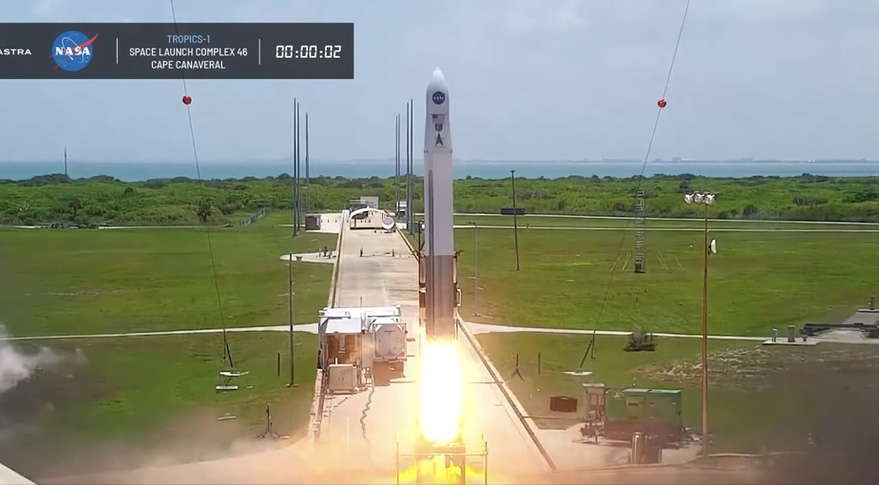WASHINGTON — Astra Space announced Aug. 4 it is canceling its existing small launch vehicle after its most recent failure and will focus instead on a much larger vehicle that may not be ready to fly customers until 2024.
In its release of its second quarter earnings, Astra said it would stop flying its Rocket 3.3 vehicle. That vehicle had failed to reach orbit three times in five launches, including its most recent launch June 12, which carried two NASA TROPICS cubesats to monitor tropical weather systems. Counting earlier versions, Rocket 3 failed five times in seven launches.
Astra said in an earnings call that it is still investigating the cause of that failure, working with NASA and the Federal Aviation Administration, which licensed the launch. Chris Kemp, chief executive of Astra, said the rocket’s first stage worked as expected, but that the upper stage suffered an anomaly that caused its engine to run out of fuel early.
The company says that it will no longer fly the Rocket 3.3 and move on to its larger Rocket 4 vehicle that it announced in May. One change is that the payload performance of the new rocket has doubled to 600 kilograms. Kemp didn’t disclose details of the design change other than an upgrade to its upper stage engine. Rocket 3.3, by contrast, had a payload capacity of no more than 50 kilograms.
“The feedback that we were getting from some of the larger constellation operators was that satellites were getting larger,” he said. Discontinuing the existing Rocket 3.3, he said, allowed the company to focus its resources on the new launch system, including increasing its payload capacity.
“Then we started talking to our customers, and it was pretty clear that, after two of the last four flights we had flown were not successful, the opportunity to fly on a vehicle that has received all of this attention and energy from our team was also favorable to them,” Kemp said.
Customers who had signed contracts for Rocket 3 launches will be re-manifested on future Rocket 4 launches, he said, including NASA. “We are in discussions with NASA to proceed with TROPICS on Launch System 2.0,” he said, which includes Rocket 4 and its ground systems.
NASA officials speaking at an Aug. 2 meeting of the agency’s Earth Science Advisory Committee suggested they had yet to decide how to launch the four remaining TROPICS cubesats. “We had contracted with a new and innovative launch company, and we knew we were taking some risk. In this case, the risk didn’t pay off,” said Karen St. Germain, director of NASA’s Earth science division.
She said NASA was talking with partners on launch plans for the other four cubesats, including a meeting that was scheduled for Aug. 3 with NASA’s Launch Services Program “to figure out what that path forward will be.”
NASA and other customers may have to wait some time for new rides from Astra. The company said it does not plan to conduct any more launches this year and will only begin test launches of the new vehicle some time in 2023. “I want to give [chief engineer] Benjamin [Lyon] time, and the team the time, to really get this right,” Kemp said.
That includes several test flights of the vehicle in addition to extensive ground testing. “There is a lot of uncertainty because we want to give the time to the team to do all that testing before we do another commercial launch,” he said when asked for a schedule for the new vehicle. “Whether we’ll be able to commence commercial launches in 2023 will depend on the success of our test flights.”
The company, which reported a net loss of $82.3 million and negative adjusted earnings before interest, taxes, depreciation and amortization of $48.4 million in the second quarter, has $200.7 million in cash and cash equivalents on hand. The company announced Aug. 2 an agreement with B. Riley Principal Capital II to sell up to $100 million in stock over the next two years.
“The company expects that its sources of liquidity will be sufficient to fund operating and capital expenditure requirements through at least 12 months,” said Kelyn Brannon, chief financial officer of Astra, on the earnings call.
Besides the work on the new launch vehicle, the company is scaling up production of its Astra Spacecraft Engine electric propulsion system. That thruster was developed by Apollo Fusion, which Astra acquired last year.
Kemp said the company had received 103 “committed orders” for the thruster as of the end of the second quarter. Astra is leasing a new 5,575-square-meter facility that will be devoted to production of the engine.
“If you look at 2023, what we’re looking at in terms of revenue forecasts will largely be spacecraft engines,” he said.
